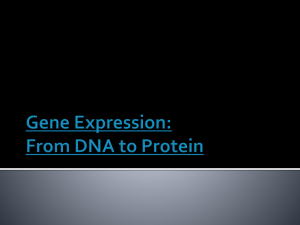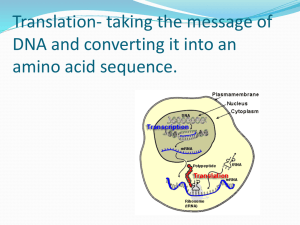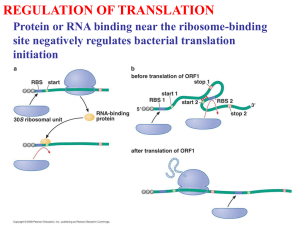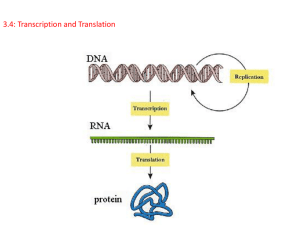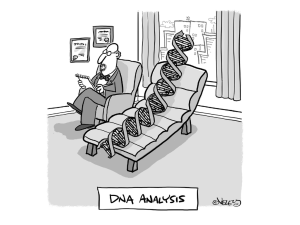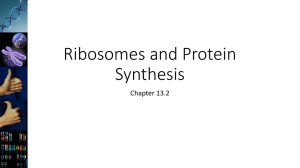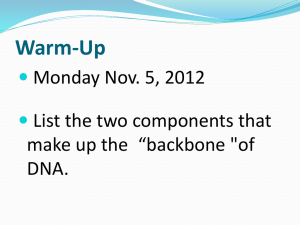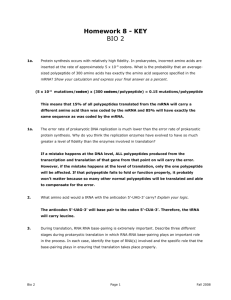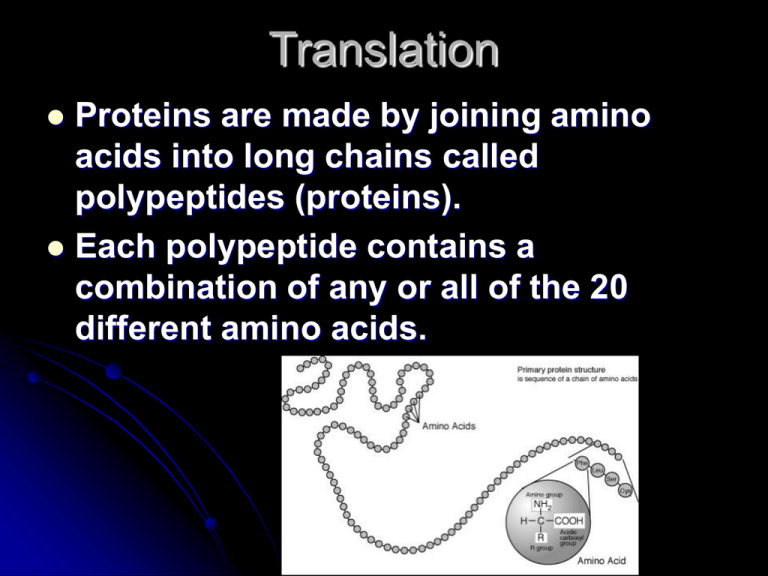
Translation
Proteins are made by joining amino
acids into long chains called
polypeptides (proteins).
Each polypeptide contains a
combination of any or all of the 20
different amino acids.
Translation
The properties of proteins are
determined by the order in which
different amino acids are joined
together to produce polypeptides.
The “language” of mRNA instructions
is called the genetic code.
Translation
RNA contains four different bases:
Adenine = A
Uracil = U
Cytosine = C
Guanine = G
Translation
These four letters carry
instructions for the 20 different
amino acids.
This genetic code is read three
letters at a time; so each “word”
of the coded message is three
bases long.
Each three-letter “word” in
mRNA is known as a codon.
A codon consist of three
consecutive nucleotides that
specify a single amino acid that
is to be added to the
polypeptide.
Translation
Example sequence:
mRNA:
UCGCACGGU
mRNA code:
UCG-CAC-GGU
Amino Acids:
Serine – Histidine - Glycine
Translation
Because there are four different bases,
there are 64 possible three-based
codons:
4 x 4 x 4 = 64
Translation
Some amino acids can
be specified by more
than one codon.
Example: 6 different
codons specify for the
amino acid leucine.
There is also one codon,
AUG, which codes for
the amino acid
Methionine.
This is also the codon
that serves as the “start
codon” for protein
synthesis
Translation
There are also three
stop codons that do
not code for any
amino acid.
Stop codons act like
a period at the end
of a sentence
Translation
The sequence of nucleotide
bases in an mRNA molecule
serves as the instructions for the
order in which amino acids
should be joined together to
produce a polypeptide.
The structures that assemble the
polypeptides from these
instructions are called
Ribosomes.
This process of decoding the
mRNA message into a
polypeptide chain (protein) is
called translation.
Translation takes place on
Ribosomes.
Step-by-Step Translation
Step 1:
Before translation
can occur,
messenger RNA
(mRNA) must first
be transcribed
from DNA in the
nucleus and
released into the
cytoplasm.
Step-by-Step Translation
Step 2:
Translation begins when
the mRNA molecule in the
cytoplasm attaches to a
ribosome (Initiation).
As each codon of the
mRNA molecule moves
through the ribosome, the
proper amino acid is
brought into the ribosome
and attached to the growing
polypeptide chain.
Step-by-Step Translation
Step 2:
The ribosome does
not know which
amino acid to match
to each codon. That
is the job of the
transfer RNA
(tRNA).
Step-by-Step Translation
Step 2:
Each tRNA has an
amino acid
attached to one end
of the molecule and
a region of three
unpaired bases on
the other
Step-by-Step Translation
Step 2:
The three bases on
the tRNA molecule,
called the anticodon,
are complimentary to
one of the mRNA
codons.
Step-by-Step Translation
Step 3:
Like an assembly line worker
who attaches one part to
another, the ribosome forms a
peptide bond between the
first and second amino acids
(Elongation).
At the same time, the ribosome
breaks the bond that held the
first tRNA molecule to its amino
acid and releases the tRNA
molecule.
The ribosome then moves to the
third codon, where a tRNA
molecule brings it the amino
acid specified by the third
codon.
Step-by-Step Translation
Step 4:
The polypeptide chain
continues to grow until
the ribosome reaches a
stop codon on the mRNA
molecule.
When the ribosome reaches
a stop codon, it releases the
newly formed polypeptide
and the mRNA molecule,
completing the process of
translation (Termination).
The Roles of RNA and DNA
You can compare the different roles
played by DNA and RNA molecules in
directing protein synthesis to the two
types of plans used by builders.
The Roles of RNA and DNA
A master plan has all the
information needed to
construct a building.
But builders never bring
the valuable master plans
to the building site, where it
might be damaged or lost.
Instead they make an
invaluable copy of the
master plans called
blueprints.
The Roles of RNA and DNA
The master plans stay safely
stored in the office, and the
blueprints are taken to the job
site.
Similarly, the cell uses the
vital DNA “master plan” to
prepare RNA “blueprints”.
The DNA molecule remains
safely in the nucleus, while
the RNA molecules go to the
protein-building sites in the
cytoplasm – the ribosomes.
Genes and Proteins
Gregor Mendel might have been
surprised to learn that most
genes contain nothing more than
instructions for assembling
proteins.
He might of asked what proteins
could possibly have to do with
the color of flowers, the shape of
the leaves, a human blood type,
or the sex of a newborn baby.
The answer is that proteins have
everything to do with these
things.
Genes and Proteins
Remember that many
proteins are enzymes,
which catalyze and
regulate chemical
reactions.
A gene that codes for
an enzyme to produce
pigment can control
the color of a flower.
Genes and Proteins
Another enzymespecifying gene
helps produce a
red blood cell
surface antigen.
This molecule
determines your
blood type.
Genes and Proteins
Genes for certain
proteins can regulate
the rate and pattern of
growth throughout an
organism, controlling
its size and shape.
In short, proteins are
the keys to almost
everything that living
cells do.

